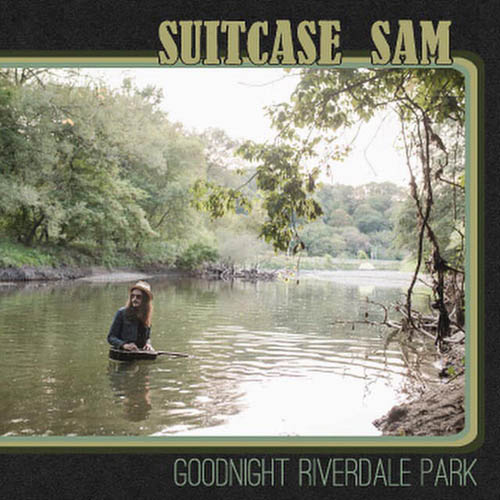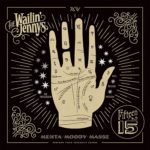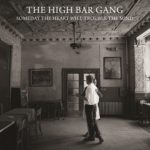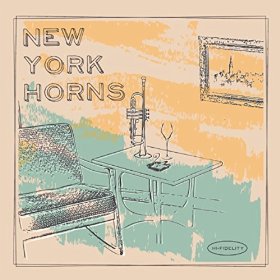
Suitcase Sam – a man with a deliberately cultivated air of mystery. Historical details are sketchy; even his website has him soaking up musical influences three years before he was born. What is clear is that a lot of soaking went on. There are musical elements on the ten songs on “Goodnight Riverdale Park” dating back to the 1920s and covering a wide variety of traditional American musical stylings. A couple of reservations here; this is a very American album and it also looks quite firmly back towards a bygone era. If both of those are your thing, then carry on reading.
In keeping with the retro stylings of the songs, the co-producer of the album, Walter Sobczak eschewed digital recording technology in favour of two and a half inch tape, creating a warmer and slightly rawer sound. More authentic, and that appears to be the main priority with “Goodnight Riverdale Park”.
The album runs through a variety of traditional American styles from the old country feel of “Friday Afternoon” and “Edge of Town” through the string band resonator-led instrumental “The Maple Leaf Stomp”, the Nashville country of “Morning Mail” (a story of waiting for news that never comes), the thirties ragtime feel of “Honey I Know” to the album’s closer, “Tattered Shoes”, a straight-ahead 12-bar blues that builds up to a slide-driven full rock band arrangement that ramps up the tempo for a big final chorus. The album’s opener “Growing Up” and “Frankie and Me” both nod in the direction of The Band with Southern Rock stylings. It’s an eclectic mix, moving effortlessly through styles and pulling in slightly unorthodox instruments such as alto sax, sousaphone, clarinet, piano and organ alongside the more usual string band, resonator, fiddle and pedal steel to provide for Sam’s Jimmie Rodgers and Hank Williams vocal stylings.
“Goodnight Riverdale Park” won’t be for everyone, but if your thing is authentic evocations of classic periods of American musical history, then give this a listen.
“Goodnight Riverdale Park” is released in the UK on Friday March 28th on Curve Music. Meanwhile, here’s the video for “Frankie and Me”:
 This was the first album I listened to on January 1 2018. Kind of appropriate really; after hearing so much beered-up musical stodge over the festive period, this is the perfect aural January detox to accompany the real thing. The Wailin’ Jennys (Heather Masse, Nicky Mehta and Ruth Moody) have been together fifteen years (hence the title), but this is their first album in six years. It’s worth waiting for; it’s gorgeous. They interpret nine very different songs but the common thread running through all of them is those three fabulous voices and the heartbreakingly pure harmonies. It’s possible I might mention that again at some point.
This was the first album I listened to on January 1 2018. Kind of appropriate really; after hearing so much beered-up musical stodge over the festive period, this is the perfect aural January detox to accompany the real thing. The Wailin’ Jennys (Heather Masse, Nicky Mehta and Ruth Moody) have been together fifteen years (hence the title), but this is their first album in six years. It’s worth waiting for; it’s gorgeous. They interpret nine very different songs but the common thread running through all of them is those three fabulous voices and the heartbreakingly pure harmonies. It’s possible I might mention that again at some point.
Everything is built around creating a setting for those flawless voices to deliver interpretations that are technically and emotionally perfect. Generally speaking, the musicians have a fairly light touch throughout the album; this is all about putting those three voices straight upfront and centre. When full string band arrangements are used, they tend to build up in layers to push the song to a higher level, which works particularly well on the timely cover of Tom Petty’s “Wildflowers” and the Jane Siberry song, “The Valley”. “Boulder to Birmingham”, Emmylou Harris and Bill Danoff’s plaintive elegy to Gram Parsons has a full band sound with some lovely two-guitar picking and percussive upright bass; none of it threatens to overwhelm the vocals.
For all the subtle and delicate playing, the a cappella or virtually a cappella material that really shines brightly. Paul Simon’s “Loves Me like a Rock” gets the handclap and fingerpop treatment, Dolly Parton’s “Light of a Clear Blue Morning” begins with a solo vocal before the stunning harmonies join, but the best is saved till last. The album’s final song is an a cappella cover of Hank Williams’ “Weary Blues from Waitin’” which not only has the expected beautiful three-part harmonies but features some incredibly precise three-part glissando harmonies. I have honestly never heard that done with such precision.
So now you’re going to ask if I like it, yeah? What a great way to start the year. But you don’t have to take my word for it; a click on any of those song links will take you to Spotify where you can hear it for yourself.
“Fifteen” is released on True North Records on Friday January 5 2018.
![imgID72704821.jpg.gallery[1]](http://musicriot.co.uk/wp-content/uploads/2017/02/imgID72704821.jpg.gallery1-150x123.jpg) ‘Well, I said hello to the spirit of 1956,
‘Well, I said hello to the spirit of 1956,
Who was stationed in the bushes next to ’57….’
Thus sang Jonathan Richman on one of the dozen best songs ever recorded, “Roadrunner”.
I encountered the same spirits on a soggy Thursday night in Leek. It’s not what you expect, really and I would have appreciated fair warning but there it is.
A modest but politely enthusiastic audience was more a reflection of the night rather than ‘the turn’. Leek, one of the highest towns in England – ‘Queen of the Moorlands’, baby – was sloshing about in the remains of the tropical storm which had brought a well-morphed spirit of the Caribbean many miles away from source. This exotic and fantastical weather ‘bomb’ was well named by the time it reached these climes.
Doris. Queen of the wet and windy.
So one for the hardy, very local or true believers.
First up, support from a local musician and leading light in the Leek Blues Fest – end of last week in September 2017 for those of you young enough to believe in the idea of forward planning – Mike Gledhill, an affable singer-songwriter who played an amiable bunch of self-penned songs, one of which he entertainingly claimed he wrote with J.J. Cale….”he just doesn’t know it yet…!” all of which amounted to a pleasant enough starter-upper.
John Lewis is, in his solo incarnation, a revelation from the second he hits the strings. Within the first four songs it is pretty obvious we’re in the presence of something a bit special here. His repertoire wanders with total comfort between 1956 rockabilly skeletons, Hank Williams-esque country painfests, straight-ahead four on the floor R’n’B – tinged rock ‘n’ roll that Chuck Berry made his own, and the prehistoric pop sensibilities of Buddy Holly. How does he manage this?
Well, for a start, this guy has A Voice. And it’s usually the voice which lets down a perfectly acceptable ‘Americana’ (hate the term – but bear with me) act, especially the blues. But this guy has got the whole thing going on. I find it incredible that one bloke’s voice can capture the essence of the pained ache of the aforementioned Hank Williams (done badly it just sounds like mawkish sentimentality – and John Lewis doesn’t appear to do mawkish sentimentality), the tremulous, vulnerable majesty of Roy Orbison, the mean, gritty swagger of some of the other Sun-era originals like Sonny Burgess, Charlie Feathers et al, and the popped-up sweetness of Buddy and yes, at one point, Elvis and of course, Johnny Cash. Not only that, he is positively expert on a range of guitars that look like they really ought to be nailed to the wall in a museum in Nashville or used as agricultural instruments.
Here is a man who is on top of his game, big style. You don’t have the likes of Imelda May helping out on his beautiful celebration of dadness, “Waltz Around the Kitchen”, or The Jets providing back-up on some of his recordings without knowing your chops. What I find similarly astonishing is the authenticity which having a ‘stamping board’ – which looks like a heavily-modified pallet – as your rhythm section. And to keep that going with metronome precision throughout a set which requires a variety of pace changes mid-song can’t be easy, not to mention physically exhausting.
What is it about the Welsh? Why do they produce such brilliant rock ‘n’ rollers? Crazy Cavan and the Rhythm Rockers; the much-maligned Shakin’ Stevens; Geraint Watkins; Ricky Valance (first Welshman to have a UK number 1 hit; ask your grandma.) Even Sir Thomas The Jones started out with beat-group derivatives of old-school r and r. And John Lewis sits fairly and squarely in the middle of this tradition. Already. And you feel there’s still plenty to come.
Perhaps the best compliment you can pay an artist who features a number of ‘covers’ in their set is that the originals are not fillers you sit through politely before he chucks in a crackling, impatient “Help Me” or an incendiary “Baby Please Don’t Go”. By focussing on the fundamentals, family relationships (“Waltz”) paying the bills or not (“Money Troubles”) or social exclusion (“Not Quite the Not”) his own stuff sits in perfect context with a whole range of classics which span early skiffle, work songs, blues and country. Modern sensibilities, mark you; “Money Troubles” is a beaut, naming the beast in a direct and modern setting. I mean, if he was writing ‘baby left me and mah mule got lame, lost mah money in a poker game’ you’d wonder quite what the point was. So he doesn’t.
And that quite stunning voice enables him to interpret an old and well-worn song with vision and flexibility. I mean, “Always on My Mind” sung by Elvis always sounds to me like ‘I may not be perfect but regarding our relationship I’m always Elvis Presley.’ Sung by Willie Nelson, it sounds like ‘I’m nowhere near perfect but regarding our relationship, this is the about the best I can manage.’ Here is an interpreter of other people’s songs who thinks about what they mean to him, not just his own material, and that isn’t necessarily a given.
Note to self; go and see The Real John Lewis, as the microphone stand proclaims, as a trio and see how that changes the dynamic of things. I’d imagine that freed from having to be his own personalised rhythm section there’d be some real pyrotechnics then. And also, must go see him in an over-full, sweaty cave somewhere filled with the drunk and the raucous rather than the sparsely-populated but admittedly lovely high-ceilinged Victoriana of the Foxlowe Centre.
I stop mid-gush to voice two slight concerns. Firstly, regards old rockabilly and rock n roll, (I flatly refuse to use the term Americana as I hate it with a vengeance) virtually the entire world is looking in a direction away from the original source of music as we know it at the moment. How is this phenomenal talent to break out of the limitations of the genre? And secondly, what exactly IS the genre? And DON’T say Americana, I will not be held responsible for my actions. Sooner or later, a ‘breakthrough’ airplay track may well compel The Real John Lewis to define himself a little more precisely than his talent would probably feel comfortable with. At that point The Real John Lewis – or a version of – might be forced to stand up. (At which point the rhythm section will fall silent, ‘cos you can’t do the stomp rhythm thing unless you’re sitting down.)
But neither of these things are the artist’s problem and neither are they particularly within his control, either.
And the latter might be a nice problem to have. It would be no more or less than he deserves.
New acoustic album “His Other Side” comes out on February 26th, I’m told. Website www.therealjohnlewis.com
 String bands, bluegrass generally; it’s not for everyone and I guess most bands making music in this genre today must be trying to attract a few new listeners, but how do you do it? You can try playing traditional tunes and be better than anyone else, but that’s not likely to bust you out of the genre. You can write new songs in the bluegrass idiom, but that’s risky unless they’re very good. The third way is to cover familiar songs in the string band style, and that’s the way The High Bar Gang have gone with their previous album of gospel songs and this album of heartbreak and death country songs. And they did one more revolutionary thing; they recorded the album in stereo, as opposed to using the traditional one–mic technique.
String bands, bluegrass generally; it’s not for everyone and I guess most bands making music in this genre today must be trying to attract a few new listeners, but how do you do it? You can try playing traditional tunes and be better than anyone else, but that’s not likely to bust you out of the genre. You can write new songs in the bluegrass idiom, but that’s risky unless they’re very good. The third way is to cover familiar songs in the string band style, and that’s the way The High Bar Gang have gone with their previous album of gospel songs and this album of heartbreak and death country songs. And they did one more revolutionary thing; they recorded the album in stereo, as opposed to using the traditional one–mic technique.
Despite a few lovely guitar solos, particularly on the opener, Dolly Parton’s “Silver Dagger” and the penultimate “Rock Salt and Nails”, the sound of The High Bar Gang is built on a solid basis of ensemble playing, the interplay between bass and guitar and the more percussive mandolin and banjo creating the rhythms that drive the songs underpinning a rich and varied series of textures and melodic settings created by seven players with various combinations of guitar, banjo, mandolin, fiddle and upright bass. There’s even some time signature variation, with almost half of the songs in ¾ time.
And then there’s the voices, working together in all sorts of combinations; two-part and three-part harmonies featuring in “How Many Times Have you Broken my Heart?” and “She’s More To Be Pitied” (sounding like a reply to the Arlie Carter and William Warren classic “Wild Side of Life”) and the male/female duet combination of “Branded Wherever I Go”. They all have that seemingly effortless lustre that only happens when a true gift is polished to perfection.
If you look at this as an experiment in adapting songs to a string band style, it’s a complete success; it should win over a few more fans to a genre that’s almost a polar opposite of everything we hear on mainstream radio. There are lovely interpretations of classic songs by Dolly Parton, Earl Scruggs, Roy Acuff, Hank Williams and Johnny Cash, all accented with perfect harmonies and melancholy fiddle fills. Who knows, it may even help them earn a well-deserved breakthrough to a wider audience.
“Someday the Heart Will Trouble the Mind” is out on August 19th on True North Records (TND622).
 It’s relatively easy to record an album these days; you can do it at home or maybe in a studio and it won’t cost you the earth. You can organise your own distribution online or at live shows; you won’t get rich but you will get some return for your creativity. Not everything released by this route is good; there are way too many vanity projects, but occasionally something really worthwhile emerges. Sometimes a group of talented and like-minded musicians get together and just play the tunes they really want to play. If it makes a few dollars, that’s fine, but that’s not really the point because the musicians are playing the music they want to play and having a bit of fun with their own original material and a few covers. Very, very occasionally the result is an album packed with, superb performances and arrangements that you want to listen to again and again. “New York Horns” is one of those.
It’s relatively easy to record an album these days; you can do it at home or maybe in a studio and it won’t cost you the earth. You can organise your own distribution online or at live shows; you won’t get rich but you will get some return for your creativity. Not everything released by this route is good; there are way too many vanity projects, but occasionally something really worthwhile emerges. Sometimes a group of talented and like-minded musicians get together and just play the tunes they really want to play. If it makes a few dollars, that’s fine, but that’s not really the point because the musicians are playing the music they want to play and having a bit of fun with their own original material and a few covers. Very, very occasionally the result is an album packed with, superb performances and arrangements that you want to listen to again and again. “New York Horns” is one of those.
So, who are the New York Horns? Well the horn players are Chris Anderson (trumpet and flugelhorn), John Isley (tenor and baritone sax and bass clarinet) and Neal Pawley (trombone and vocals) and they’re better known as the horn section of Southside Johnny the Asbury Jukes. Here they’re aided and abetted by fellow-Jukes Jeff Kazee (piano, Hammond B3, keys and vocals) and Glenn Alexander(guitars, dobro, mandolin and vocals) and a rhythm section of Shawn Pelton (drums and percussion) and Tony Tino (electric bass).
The album opens with a very different instrumental take on KT Tunstall’s breakthrough song “Black Horse & the Cherry Tree”. Where the original builds gradually by using a loop pedal for instrumental and vocal parts, the NYH version comes in, after a quick guitar intro, at full strength with Latin American percussion (courtesy of Marc Quinones) and perhaps a hint of early Santana. Chris Anderson’s tone poem “Morningside at Midnight” is next, taken at a walking tempo, and evoking the spirit of Morningside Heights with electric piano, wah-wah guitar and unison sax and trumpet. The Hank Williams classic “Hey Good Lookin’” is the first vocal piece, driven along by a guitar riff and horn fills before the sax, guitar and Hammond solos kick in. “Song for Levon”, a Chris Anderson and John isley co-write is a tribute to Levon Helm. It’s stately and mournful in classic New Orleans tradition and features Southside Johnny as guest harmonica player.
The uptempo jazz-funk of John Isley’s “Little Miss Thing” wouldn’t sound out of place on either of Donald Fagen’s first two solo albums and features the first trombone solo on the album from Neal Pawley; it’s great fun. “Can’t Stand to See You Cry”, written and sung by Jeff Kazee, is a powerful soul song with a superb plaintive vocal and an arrangement that Allen Toussaint would be proud of while “Strollin’ With Sean” is a fairly straightforward blues driven along by a horn riff and it’s another chance for the guys to solo for all they’re worth and have a great time. The final cover on the album is John Hiatt’s “Little Head” which retains the feel of the original while adding punch with horn fills.
John Isley’s “78 Below” opens with an uptempo Nile Rodgers –style lead/rhythm riff which, with the punchy bass, drives the piece along underneath a staccato muted trumpet melody before the mood mellows again with Chris Anderson’s “More Than Tears”. Opening with a restrained combination of piano, acoustic guitar and mandolin, this moody and melancholic piece is perfect for the flugelhorn which Chris uses to carry the main melody. John Isley’s “Under the Hood” is an atmospheric piece using Hammond and the horn ensemble to create the mood and features a muted trumpet solo from Chris Anderson. The album’s closing song, “Nothing Left to Say”, opens slowly in New Orleans jazz funeral style, with a guest vocal by Christine Ohlman before erupting just before the halfway mark into uptempo New Orleans jazz with trumpet and sax counterpoint. There’s also a lyrical message here which underpins the whole album; however bad things get, there’s always music to pull you back, whether you play it or listen to it. It’s a perfect way to close the album.
The beauty of this album is that it was made because the musicians involved really wanted to make it. They had a lot of ideas and they wanted to get those ideas out there to people who might want to hear them. It’s not about focus groups or marketing teams; it’s about strong, sometimes very personal, material arranged well and played superbly. If you need to label it, I suppose it’s jazz, but it also pushes out in other directions as well, towards funk and old school soul; there’s certainly plenty of variety on display. Check out some of the song links here and think seriously about buying yourself a copy, if only to let a bunch of great musicians know that some people out there are actually getting the message.
Available now from Amazon and iTunes.


